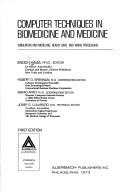| Listing 1 - 10 of 22 | << page >> |
Sort by
|
Book
ISBN: 3540079920 3642481485 Year: 1976 Publisher: Berlin Springer
Abstract | Keywords | Export | Availability | Bookmark
 Loading...
Loading...Choose an application
- Reference Manager
- EndNote
- RefWorks (Direct export to RefWorks)

ISBN: 3525562667 9783525562666 Year: 1991 Volume: 59 Publisher: Göttingen: Vandenhoeck und Ruprecht,
Abstract | Keywords | Export | Availability | Bookmark
 Loading...
Loading...Choose an application
- Reference Manager
- EndNote
- RefWorks (Direct export to RefWorks)
Theodicy --- History --- History of doctrines. --- Philosophy --- History. --- 2 BARTH, KARL --- 21 --- 234.35 --- -History --- -#GROL:SEMI-230.24 Bart --- Annals --- Auxiliary sciences of history --- Evil, Problem of (Theology) --- God --- Permissive will of God --- Problem of evil (Theology) --- Good and evil --- Godsdienst. Theologie--BARTH, KARL --- Theodicee. Natuurlijke godsleer. Natuurlijke theologie --- Werking van God in de geschiedenis. Historiciteit. Theologie van de geschiedenis --- History of doctrines --- Permissive will --- Will, Permissive --- Barth, Karl --- بارث، كارل --- カール・バルト --- 234.35 Werking van God in de geschiedenis. Historiciteit. Theologie van de geschiedenis --- 2 BARTH, KARL Godsdienst. Theologie--BARTH, KARL --- #GROL:SEMI-230.24 Bart --- Philosophy&delete& --- Barth, Karl, --- Parŭtʻŭ, Kʻal, --- Barth, Karol, --- Barŭtʻŭ, Kʻal, --- Barŭtʻŭ, --- Bate, --- בארת, קרל, --- カール·バルト, --- 巴特, --- Theodicy - History of doctrines. --- History - Philosophy - History.

ISBN: 087769141X Year: 1973 Publisher: Philadelphia (Pa.) : Auerbach,
Abstract | Keywords | Export | Availability | Bookmark
 Loading...
Loading...Choose an application
- Reference Manager
- EndNote
- RefWorks (Direct export to RefWorks)
Computers. --- Medicine. --- Computer-Assisted Instruction. --- 615.84 --- Medicine --- -Clinical sciences --- Medical profession --- Human biology --- Life sciences --- Medical sciences --- Pathology --- Physicians --- Medical Specialities --- Medical Specialties --- Medical Specialty --- Specialities, Medical --- Specialties, Medical --- Specialty, Medical --- Medical Speciality --- Speciality, Medical --- Calculators, Programmable --- Computer Hardware --- Computers, Digital --- Hardware, Computer --- Calculator, Programmable --- Computer --- Computer, Digital --- Digital Computer --- Digital Computers --- Programmable Calculator --- Programmable Calculators --- Fysische middelen. Elektrotherapie. Radiotherapie. Laser. Radiologie --- Data processing --- Data processing. --- -Fysische middelen. Elektrotherapie. Radiotherapie. Laser. Radiologie --- Computer-Assisted Instruction --- Computers --- Programmed Instruction, Computerized --- Self-Instruction Programs, Computerized --- Computer Assisted Instruction --- Computer-Assisted Instructions --- Computerized Programmed Instruction --- Computerized Self-Instruction Program --- Computerized Self-Instruction Programs --- Instruction, Computer-Assisted --- Instruction, Computerized Programmed --- Instructions, Computer-Assisted --- Program, Computerized Self-Instruction --- Programs, Computerized Self-Instruction --- Self Instruction Programs, Computerized --- Self-Instruction Program, Computerized --- Computers in medicine --- Health Workforce --- Augmented Reality
Book
ISBN: 9811361711 9811361703 Year: 2019 Publisher: Singapore : Springer Singapore : Imprint: Springer,
Abstract | Keywords | Export | Availability | Bookmark
 Loading...
Loading...Choose an application
- Reference Manager
- EndNote
- RefWorks (Direct export to RefWorks)
This book investigates phase transitions and critical phenomena in disordered systems driven out of equilibrium. First, the author derives a dimensional reduction property that relates the long-distance physics of driven disordered systems to that of lower dimensional pure systems. By combining this property with a modern renormalization group technique, the critical behavior of random field spin models driven at a uniform velocity is subsequently investigated. The highlight of this book is that the driven random field XY model is shown to exhibit the Kosterlitz–Thouless transition in three dimensions. This is the first example of topological phase transitions in which the competition between quenched disorder and nonequilibrium driving plays a crucial role. The book also includes a pedagogical review of a renormalizaion group technique for disordered systems. .
Book
Year: 1972 Publisher: Belmont Fearon
Abstract | Keywords | Export | Availability | Bookmark
 Loading...
Loading...Choose an application
- Reference Manager
- EndNote
- RefWorks (Direct export to RefWorks)
Book
Year: 1995 Publisher: Kyoto International research center for Japanese studies
Abstract | Keywords | Export | Availability | Bookmark
 Loading...
Loading...Choose an application
- Reference Manager
- EndNote
- RefWorks (Direct export to RefWorks)
Book
ISBN: 9783525550373 Year: 2012 Publisher: Göttingen Vandenhoeck und Ruprecht
Abstract | Keywords | Export | Availability | Bookmark
 Loading...
Loading...Choose an application
- Reference Manager
- EndNote
- RefWorks (Direct export to RefWorks)
Book
ISBN: 3030199746 3030199738 Year: 2020 Publisher: Cham : Springer International Publishing : Imprint: Palgrave Pivot,
Abstract | Keywords | Export | Availability | Bookmark
 Loading...
Loading...Choose an application
- Reference Manager
- EndNote
- RefWorks (Direct export to RefWorks)
This book provides a rhetorical manual for political and business leaders to motivate followers even in times of hardship. It covers the fine art of persuasion and argues that there are four speeches every leader has to know: the opening speech, the executioner speech, the consolation speech, and the farewell speech. The authors explore how leaders could speak in order to appear credible to an audience, and they argue that the leader has to take on suffering and give meaning to suffering people experience. To be persuasive, the speaking leader therefore has to acknowledge that life is inscribed in the reality of change and suffering. The point is not to glorify suffering, but to acknowledge the depths of the human condition and how this knowledge may shape the art of speaking well. The book analyzes speeches from a wide variety of speakers, including Sir Winston Churchill, Barack Obama, Nelson Mandela, and Angela Merkel, and ends with a rhetorical dictionary for leaders to help readers familiarize themselves with helpful terms from rhetorical theory. Bård Norheim is Associate Professor of Practical Theology at NLA University College, Norway. Joar Haga is Associate Professor II of Church History at NLA University College, Norway, and Associate Professor of Church History at VID Specialized University, Norway.
Narration (Rhetoric) --- Leadership. --- Ability --- Command of troops --- Followership --- Narrative (Rhetoric) --- Narrative writing --- Rhetoric --- Discourse analysis, Narrative --- Narratees (Rhetoric) --- Political communication. --- Political leadership. --- Political Communication. --- Political Leadership. --- Business Strategy/Leadership. --- Leadership --- Political communication --- Political science
Book
ISBN: 0387709169 0387709150 Year: 2022 Publisher: New York, New York : Springer,
Abstract | Keywords | Export | Availability | Bookmark
 Loading...
Loading...Choose an application
- Reference Manager
- EndNote
- RefWorks (Direct export to RefWorks)
This engaging book offers the general reader a succinct account of advances in genetics and genomics, showing their influence on our understanding of health and medicine, evolution, and biology, and how they push the boundaries of ethics and social values.
Genetics. --- Biology --- Embryology --- Mendel's law --- Adaptation (Biology) --- Breeding --- Chromosomes --- Heredity --- Mutation (Biology) --- Variation (Biology) --- Medical genetics. --- Genomics. --- Genètica --- Genòmica
Book
ISBN: 9811998531 9811998523 Year: 2023 Publisher: Singapore : Springer Nature Singapore : Imprint: Springer,
Abstract | Keywords | Export | Availability | Bookmark
 Loading...
Loading...Choose an application
- Reference Manager
- EndNote
- RefWorks (Direct export to RefWorks)
This open access book includes forty-one chapters about foreign observers’ discourses on Japan. These include a wide range of perspectives from the travelogues of curious visitors to academic theses by scholars, which offer us a broad spectrum of contents, reflecting a variety of attitudes toward Japan. The works were written during the period from the 1850s to the 1980s, a timespan during which Japan became, in stages, more open to the outside world after a long isolation under the Tokugawa shogunate. From the perspective of “Japanology,” one can discern three distinct periods of rising interest in the country from abroad. The first tide of such interest came shortly after the opening of Japan, when various foreign travelers, including those who could not be included in this book, came over and wrote down their impressions of the country—which was, for them, a land of mystery and mystique, which had just opened its doors to them. The second wave arose at the beginning of the twentieth century, just after the Russo-Japanese War, when Japan again generated a remarkable surge of interest as a “miracle” in Asia that had pulled off the wondrous feat of defeating a white superpower. The third wave was more recent, which took place from the late 1960s to the 1980s, a period of high economic growth when the “miracle” of Japan’s remarkable economic recovery from the defeat of World War II attracted enthusiastic and curious attention from the outside world once again. It is not the intention of this book to directly highlight such historical transitions, but these forty-two brilliant mirrors (forty-one chapters, including forty-two discourses), even when looked in casually, provide us with unexpected insights and various perspectives. Shōichi Saeki (1922–2016) was Professor Emeritus, the University of Tokyo. Tōru Haga (1931–2020) was Professor Emeritus, International Research Center for Japanese Studies. .
Oriental literature. --- Philosophy, Japanese. --- Japan—History. --- Diplomacy. --- International relations—History. --- Asian Literature. --- Japanese Philosophy. --- History of Japan. --- Diplomatic and International History. --- History --- International relations --- Japanese philosophy --- Asian literature --- Japan --- Description and travel. --- Description and travel
| Listing 1 - 10 of 22 | << page >> |
Sort by
|

 Search
Search Feedback
Feedback About UniCat
About UniCat  Help
Help News
News